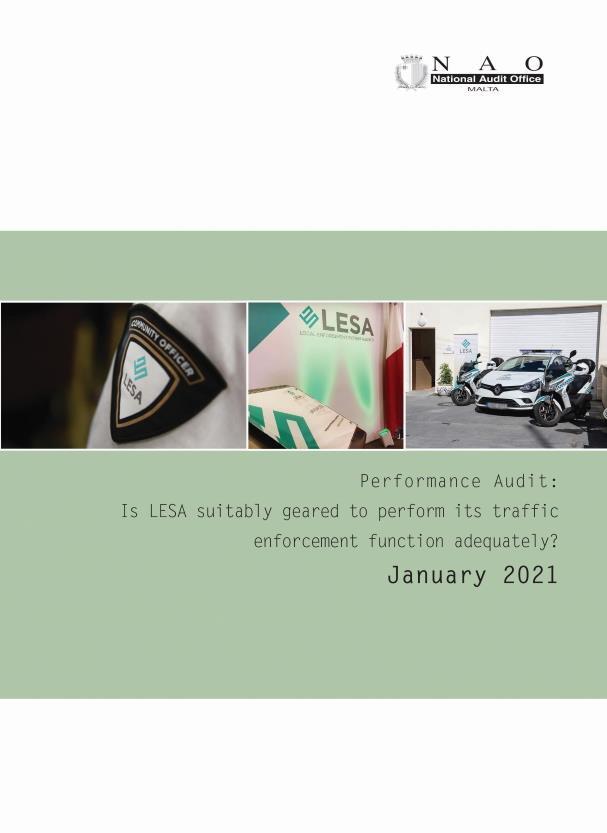- Home
- Publications
Publications
You may browse through our online list of NAO publications which include audit reports and annual reports. The audit reports are categorised according to the Classification of the Functions of Government (COFOG) developed by the OECD.
All Publications- Categories
- Publications Archive
- Events
- Careers
- About Us
 Public Order and Safety January 2021
Public Order and Safety January 2021Performance Audit: Is LESA suitably geared to perform its traffic enforcement function adequately?
Download PublicationPress Release
LESA’s potential as an enforcement Agency is evident, but it requires investment in the quality and quantity of its officers as well as better planning in resource allocation
Auditor General Mr Charles Deguara today presented the performance audit report in caption to the Speaker of the House of Representatives Dr Anglu Farrugia. This audit was carried out to determine whether this Agency is suitably geared to perform its traffic enforcement function adequately.
Throughout this review the audit team noted LESA’s recurrent concern that, in the absence of a financial allocation from central Government, it has to rely solely on the revenue it generates from the issuance of contraventions to finance its operations. Further compounding this concern, the Agency is legally obliged to re-distribute any net surpluses among Local Councils. This Office acknowledges that this situation could lead to a scenario whereby LESA’s revenue would decrease if its effectiveness, as a deterrent against traffic related infringements, increases.
This audit found that the Agency is not managing to recruit the number of community officers (COs) it contends are required. This review however also observed that the exact quantity of LESA’s ideal complement, and its allocation across the five geographical regions, is not validated through a comprehensive and adequately documented study. Such an exercise, this Office noted, would ascertain a more efficient, effective and risk-oriented allocation of officers.
NAO also highlighted concerns on the quality of some of LESA’s COs, particularly their lack of basic soft skills. As COs are the primary point of contact between the Agency and the general public, this Office feels that this issue is having a negative impact on LESA’s projected image. This concern is further compounded as a number of these individuals also lack basic technical skills and do not exhibit the willingness to address such shortcomings.
This study also found that, despite being backed by an extensive information system, the Agency still does not have a systematic and formal process by which to comprehensively monitor its COs performance. The audit team observed that the monitoring being undertaken could be more analytical and is not compiled into a single, structured and comprehensive profile for every CO.
The audit team found that significant gaps prevailed in LESA’s coverage over the local arterial road network, insofar as speed cameras are concerned. Furthermore, this Office observed that the Agency has as yet never commissioned a study which accurately determines all the areas in which CCTV or speed cameras are required on a national level.
This Office commends LESA’s initiative to commission a Cost Benefit Analysis (CBA) to determine whether the current arrangement, through which CCTV and speed cameras are being secured, presents good value for money when compared with other possible options. Notwithstanding, NAO notes that, as at time of writing, the results of this CBA (which concluded that an alternative arrangement would present better value for money) have not as yet been fully implemented even if a year had already elapsed since its completion, thereby possibly eroding this exercise’s validity. The audit team also reviewed the one year contract extension governing the procurement of CCTV and speed cameras and found that this agreement could have better safeguarded Government’s interests.
Despite the above concerns however, NAO believes that LESA is an entity with the potential to change. If the concerns outlined throughout this report are duly addressed by the Agency, NAO believes that LESA’s image will be enhanced and that the provision of a higher quality and more comprehensive service can be secured.
These issues, along with others, are comprehensively presented in the audit report together with this Office’s recommendations.
